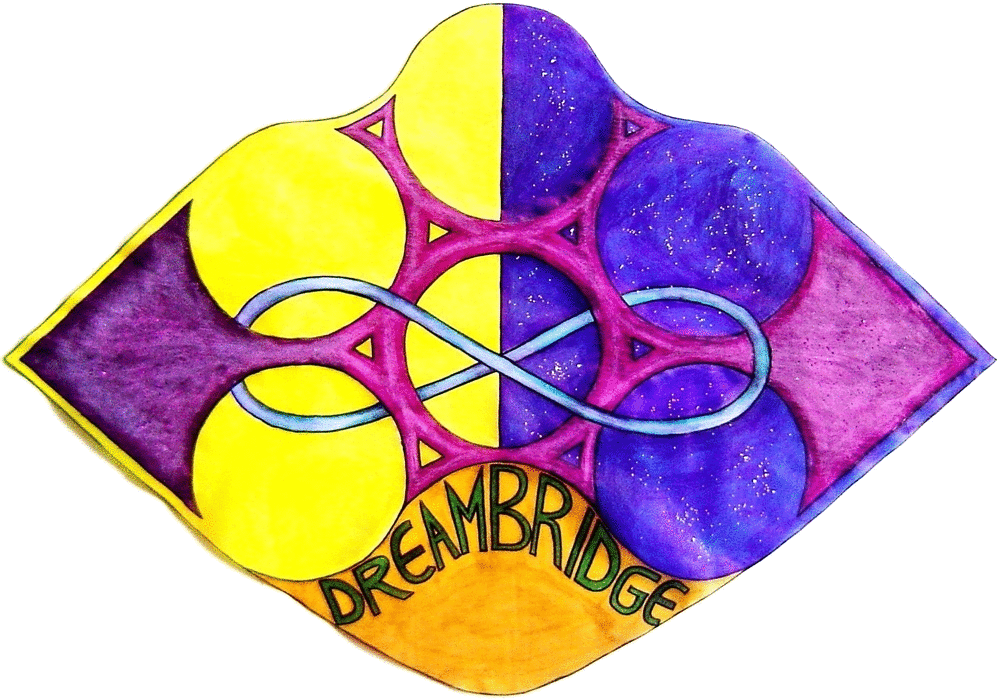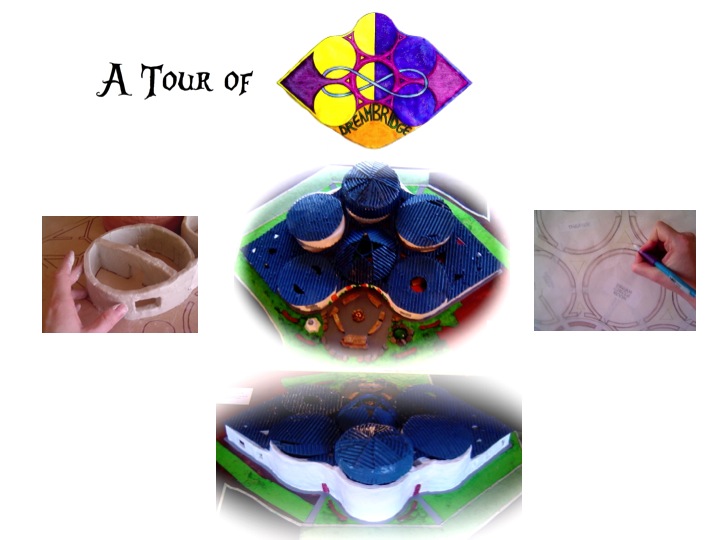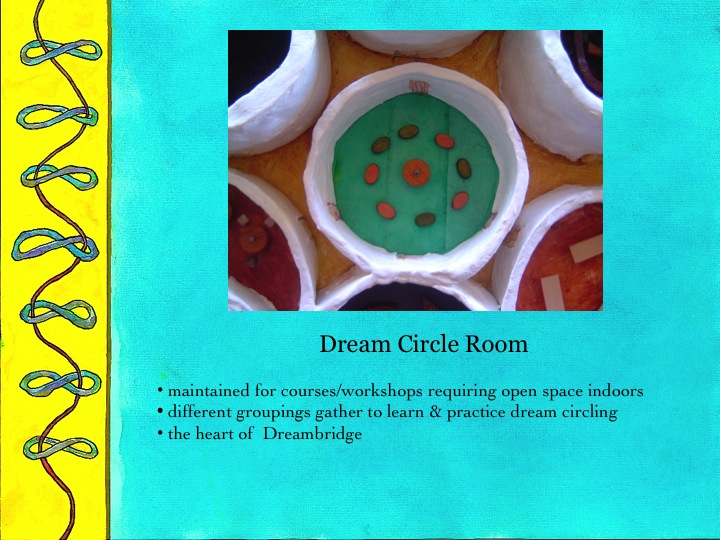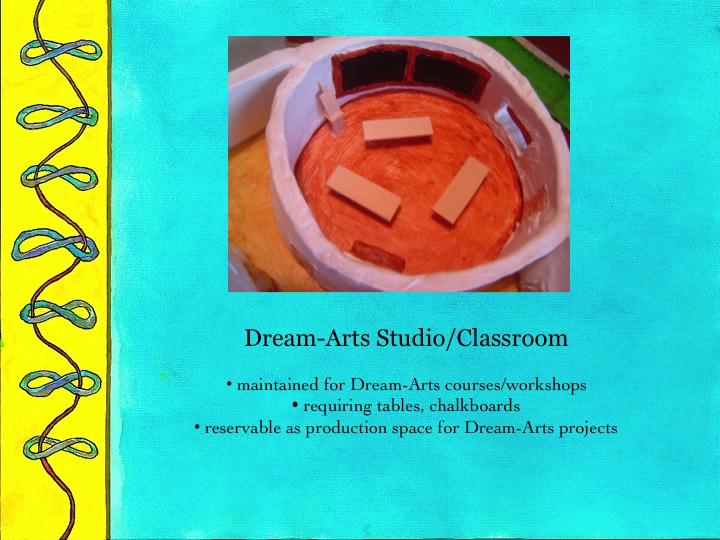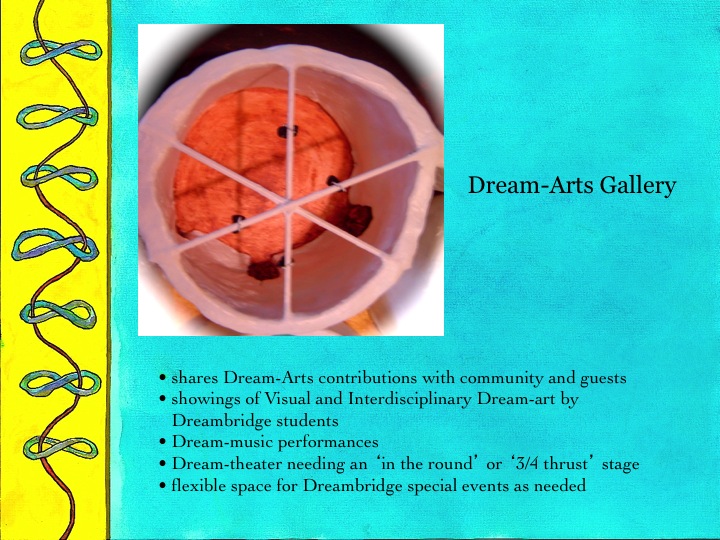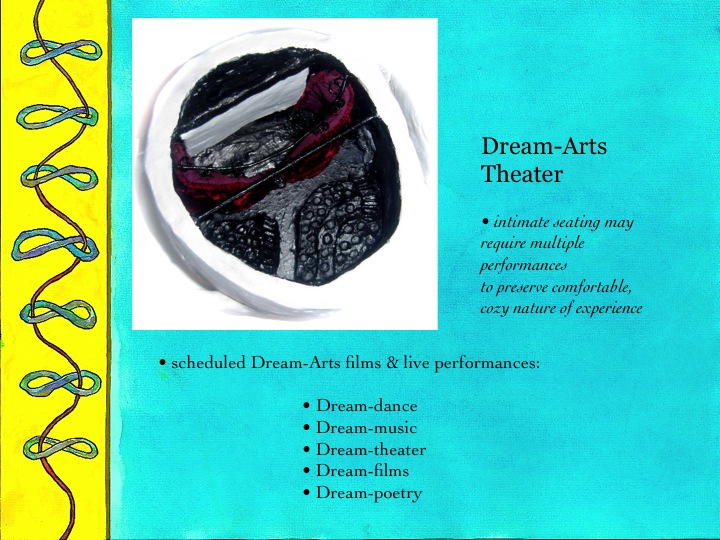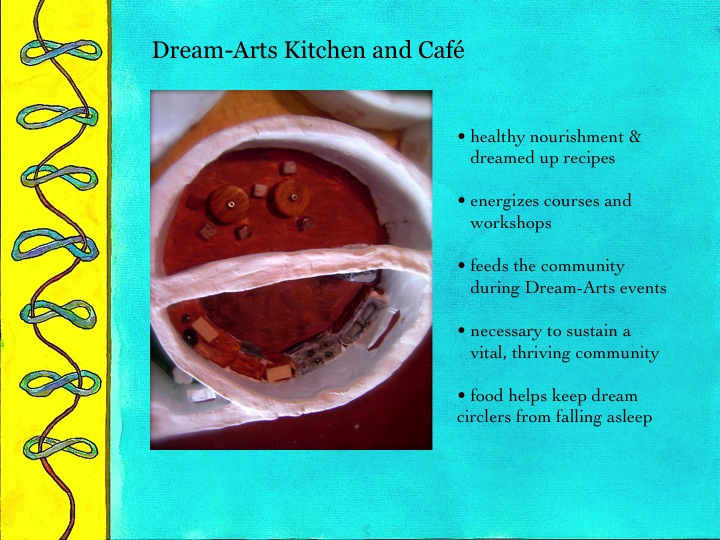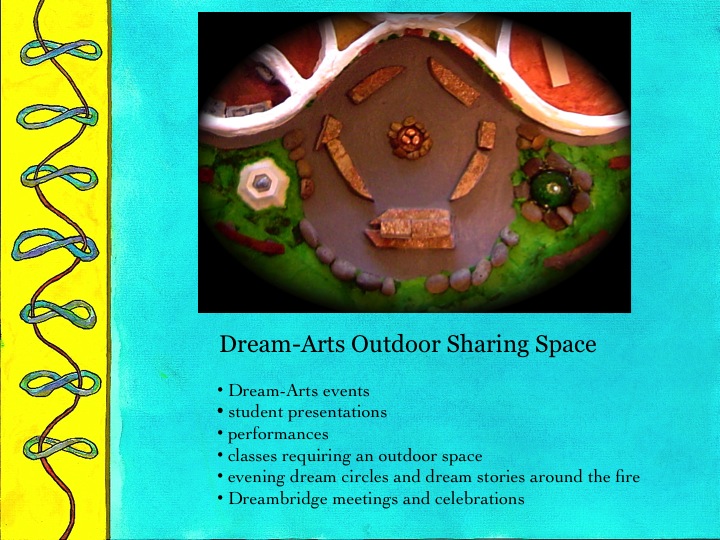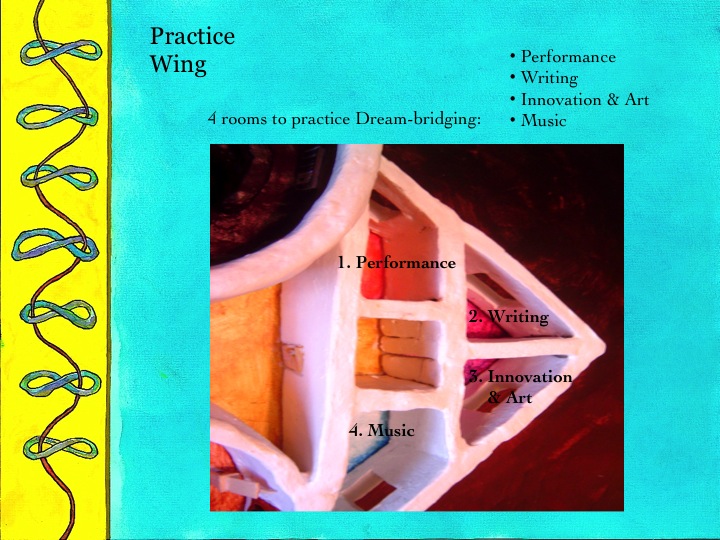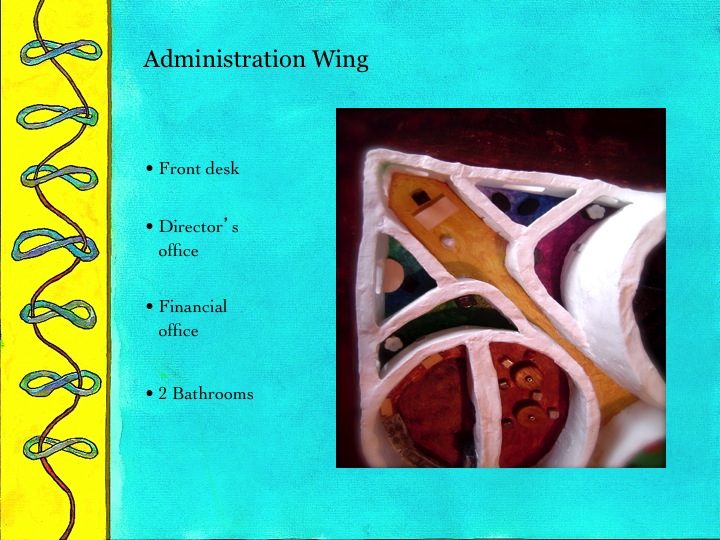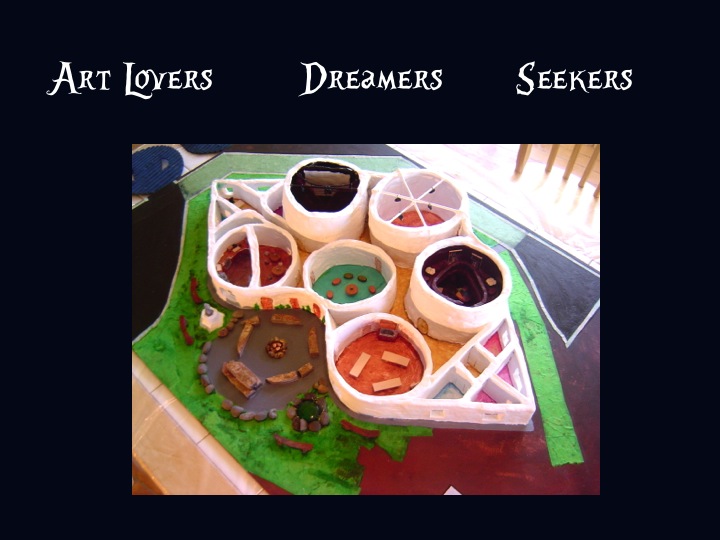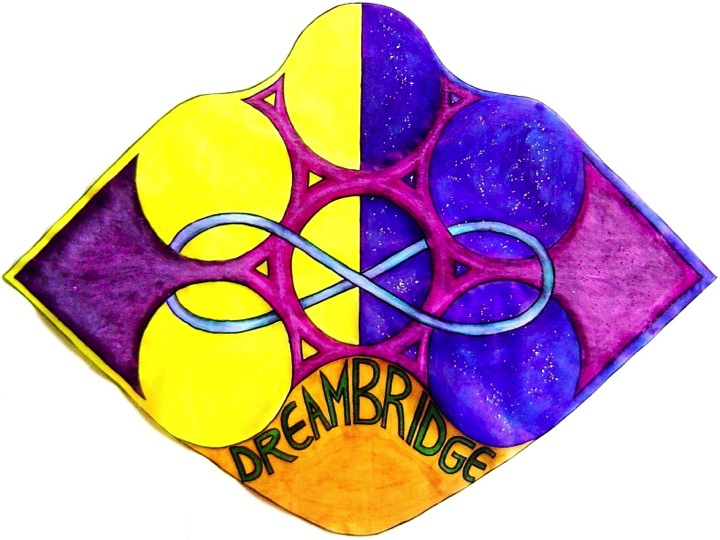"The Dreambridge Dream-Arts Center is an innovative architectural structure in response to our human need to: survive, heal, thrive, evolve, express our creativity, move toward self-actualization, and cooperate in a society of improved mental, physical, and emotional health. As cyberspace increases in power, ‘real space’ and ‘real time’ are often perceived as archaic—and too much that is healthy and meaningful about socially connecting in physical human experience is then lost. I developed the Dreambridge Dream-Arts curriculum because when people physically gather to share dream experiences through creative expressions in community, it is incredibly healing for them. Dreamwork helps people reconnect with their most authentic selves. Exciting breakthroughs occur both personally and collectively. The Dreambridge vision aims to incarnate a center that encourages the healthy creativity needed to make real and necessary changes in our lives—by bridging dreamwork into physical manifestations of the waking-life-world. Dream education and dream circling aid in the evolution of human consciousness because of their ability to empower individuals with sympathy, understanding, self-esteem, and a sense of community. In my experience, one of the best ways to bridge the benefits of dreamwork into our waking-life-world is through creative expression and the Arts."
-Dr. Angel Morgan, Ph.D.
Creating a Structure
By Dr. Angel Morgan
When I was a doctoral student at Saybrook University in San Francisco, in collaboration with my development of a dream-arts curriculum here in Ashland, Oregon, an innovative structure was calling to be born. I began to visualize the conception of a physical space in which this new curriculum could be implemented to its maximum potential. Drawing the first draft of a floor plan was my first acknowledgement of this conception. I had done so in a very lucid state of mind, quite open to what would flow onto the paper in the most natural way. I was on my way to creating a floor plan and prototype model for Dreambridge: A Dream-Arts Community Center.
I wanted to create spaces that would be both functional and beautiful, and to facilitate the needs of the groups and individuals of all ages in building the bridge between their dreams and waking lives. The future students of Dreambridge will do this through many different forms of creative expression. They will need to be in a setting that is intimate enough to feel supported in their work, but large enough for their environment to be inspiring and exciting to them. It would need to be equally inspirational to guest audiences and visiting members of the community.
Design Choices
The interdisciplinary skill of “dream-bridging” requires the right kinds of spaces, and in order to draw them, I relied primarily on the three words that had guided me most when I was a Waldorf teacher: imagination, inspiration, and intuition (Steiner, 1963). The approach I took to design was originally inspired by the creative and organic, flowing nature of Anthroposophical architecture of Rudolf Steiner, who "conceived of the liberation of form as part of a much broader quest that would define the spiritual essence in modern existence. Free form and organic motifs in architecture were intended to contribute to an environment of healing in a technological age. Architecture was both context and catalyst for a higher state of human development… Steiner stated in a lecture given in 1914: ‘And when we animate everything that presses, bears, and curves, that crafts surfaces and masters completed forms –we begin to live by opposing and playing with the forces that shape the world, and by creating art we explore fantasy and endless metamorphoses.’" (Brumfield, 1991, p.264)
I was also inspired by the versatility of straw bale building, which allows for beautiful, adaptable walls that “can be built to suit a variety of esthetics. From rounded and lumpy to straight and elegant, straw walls can take on many shapes and textures depending on how they are detailed. Finishing choices are almost unlimited” (Magwood, Mack, & Ohi, 2000, p. 8).
Another draw for me to the idea of working with straw bale in my design was the quiet, ambient aspect of the inside atmosphere in these structures (p. 8), as there would surely be multiple activities occurring at once that would require soundproofing between rooms. The environmentally friendly fact that straw bale walls save energy by requiring less heating and cooling was also attractive to me, and influenced my choice to design thick, circular and curved walls.
Elements of the Floor Plan
After it was drawn up, the floor plan contained these rooms: a central dream circle room, an art studio/classroom, four practice rooms, a store with dream-arts books and supplies and a reading area, an art gallery, a theater with a stage and screen, two bathrooms, the Director’s office, a front desk administration area, a financial office, a kitchen and eating area, and an outdoor sharing space with a fountain, pond, and fire pit.
The DREAMBRIDGE Dream-Arts Center
Unplanned Surprise Foundation
After drawing the floor plan, I observed that in the unseen spaces between what I had drawn, there was an impression of a peace sign, weaving through the center of the buildings and flowing through the doorways, connecting the circular rooms and outdoor space with the message of peace. Since this was not a conscious decision for me to draw it that way, it was a wonderful discovery, and felt as if it had appeared from my dream-mind as some kind of messenger. Although I knew this impression would not be seen from above the structure due to roofing, it felt to me that its message of peace will function similarly to a foundation stone, which is often buried underneath the foundation to protect and energize the inside of buildings in Anthroposophical architecture (Steiner, 2000). The difference here is that first, it is made of air and not stone, and second, it is invisible but not buried. If all the doors are opened wide, time made and the space cleared, people will be able to walk the path of the peace sign if they want to. The center of the large, all-encompassing peace sign embraces a smaller, central peace sign with the walls of the dream circle room. At this stage of gestation, I recognized that this very special “baby” was a “love child.” In the drawing of the floor plan, I lightly colored the invisible peace signs so they could be seen more easily, although I did not choose to color it in when making the three-dimensional model.
I had configured the seven large circle rooms into a hexagonal shape, due the harmonious aspect of sacred geometry, and the common appearance of the hexagon in water crystals that have been linked to the most positive, and healing emotions (Emoto, 2005). Steiner often said that the integration and coherence of architecture integrated into a community has an affect on social harmony (Steiner, 1927). The more angular shapes I designed on the ends of the facility grew out of the need for a connecting “skin” on the outside of the central rooms, to help integrate, and “bridge” their functions. The result reminded me of wings, extending out from an angelic messenger of peace.
Selecting The Materials
I decided to use air-drying modeling clay that would be compatible with paint, glue, and paper. I had an aesthetic sense of color and direction without a finished picture in mind. This stage of shopping for the materials reminded me of preparing a “nest” for an expected child, without knowing the sex or being influenced by gender. Letting it be what it is going to be, and assisting the growth process with love was my task.
Getting Messy
Working on the walls of each room in clay gave me a real sense of purpose. The dream circle community that I was hosting as facilitator at the time started to take notice and want to become involved, just the way people in a community notice a round belly, and want to help when the time comes. The idea was exciting, and everyone could not wait to see the new “baby.”
Taking Shape
At that point, I could see that this structure would be coming into reality, and there was no turning back. It was like feeling an in utero kick and push on my organs, and I had to stretch myself larger in order to take care of it. Before I knew it, weeks had passed and it was time for me to gesso, and to integrate everything into one cohesive body.
Painting The Bones
Painting the hallway floor was like defining a skeleton and strengthening the bones. I chose a gold-yellow hue and was pleased with the result. It looked light and sunny, warm and inviting.
Finishing The First Room
The first room I was inspired to paint, drape, and finish was the theater. I designed this space after a theater from my dreams that appeared and re-appeared in them on several occasions over the years. It is black, with a white scrim/screen and red velvet curtains. The completion of this space “set the stage” for the rest.
Forming Organs
Every room had a purpose in relation to the other rooms; similar to the way our organs have special functions in relation to each other. I engaged in creating the individual rooms, each one uniquely indicating and emphasizing the flavor of its function. I used small glass, metal, and marble beads, wood, stone, paper, paint, and glue to complete the spaces. Each time, I imagined myself at work in the room, and imagined others at work there too. My dream community in Ashland also began seeing themselves at work and play in these spaces. Nagging for completion, and telling me they wanted this creation to manifest in its full size, I felt encouraged to work harder to complete the model. It was a lot of hard work, and took more time than I had predicted.
The “Ninth Month” Roofing Blues
The outside space did not come together easily, and I was feeling rather frustrated at this phase of the artistic process. I decided to back off for a while, and when I did, I realized that in order to complete the outside landscaping, it needed the roof first. sketched a rendering of the building from the front, and added a red tile roof on the first draft. After some reflection on this design, I decided to change the red tile to blue, as I was not really going for the look of a Mission. I searched online and found some pictures of Chinese blue glazed tile roofing that I liked. Without a lot of knowledge about roofing, I still had the desire for solar paneling, and skylights everywhere. I left as much as I could flat for the solar paneling, and traced skylights over the floor plan in as many spaces as made sense. This stage felt like the ninth month of a pregnancy, whenthe belly is big and the expectant mother grows impatient for the birth of the child. It was also difficult to think about much else, and consumed most of my days.
Transformation Recognition
I cut the main roof shapes out of corrugated cardboard, and glued pieces together until I was satisfied enough with the shapes. After I set them down and spray-painted them blue, I noticed that the large, flat, skeletal part of the roof was in the shape of a bat, hanging upside down. This was significant to me because the bat is a “power animal” (Andrews, 1993) for me, and has been for many years. To me, the bat signifies transformation by death and re-birth, which are primary aspects of the inner work I do with dreams. Bats are also creatures that are awake at night, a symbol to me for lucid dreaming. Like the peace sign beneath it, this roof shape was a product from my subconscious. I may not have planned them, but the intentions were clearly there.
Enlightenment
The skylights placed over the rooms, looked natural and fluid. I could imagine the rooms and hallways filled with natural light from the sun, moon and stars. It was beautiful. Placing the final roof pieces on Dreambridge felt incredibly satisfying. It allowed me to finish the outdoor space and landscaping as much as possible, without overdoing details, and leaving enough room for the dream to keep dreaming itself. Some of the earth I left uncovered on one side for that purpose; to indicate future dreaming of what to do there, such as: a garden space, storage buildings, or anything else I have not dreamed about yet that will be needed in the life of Dreambridge.
Discussion and Conclusion
My experience of engaging in this arts based inquiry would probably have left me with some pretty hefty stretch marks, had I not felt so “downstream” in my flow with it all (Hicks, 2007). The hard work of the process was enhanced by the joy of it, and as much as I loved creating this project, I consistently reminded my creative self to take care of my “mothering” body, soul and spirit. I think and feel that doing so has fed the project and made it more abundant and thriving.
It would feel like an understatement to say that this experience has been an important task for me. It has allowed me to apply my imagination, inspiration, and intuition (Steiner, 1963) in the creative formation of a model that could bridge dreamwork with creativity in a cooperative community environment. In fact, this baby integrates all of my passion for: Dream Education, Creativity, the Arts, Community, Human Development, the Evolution of Consciousness and Spirituality, and living in harmony with our natural Earth.
Although it felt incredibly fulfilling to have explored this vision that came through me by way of an arts based inquiry in architectural design, I know it was only the beginning. The Dreambridge has its life ahead of it.
References
Andrews, T. (1993). Animal speak: The spiritual and magical powers of creatures great and small. St. Paul, MN: Llewellyn Publications.
Brumfield, W.C. (1991). The origins of modernism in Russian architecture. Berkeley: University of California Press.
Emoto, M. (2005). The hidden messages in water. New York: Simon & Schuster.
Hicks, E., & Hicks, J. (2007). The astonishing power of emotions: Let your feelings be your guide. Carlsbad, CA: Hay House, Inc.
Magwood, C., Mack, P., & Ohi, E. (2000). Straw bale building: How to plan, design and build with straw. Gabriola Island, B.C.: New Society Publishers.
Steen, A.S., Steen, B., Bainbridge, D., Eisenberg, D. (1994) The straw bale house. White River Jct., VT: Chelsea Green Publishing
Steiner, R. (1927). Ways to a new style in architecture. London: Anthroposophical Publishing Company.
Steiner, R. (1963). The philosophy of spiritual activity. New York: The Rudolf Steiner Publications, Inc.
Steiner, R. (2000). Architecture as a synthesis of the arts. London: Rudolf Steiner Press.
a tour of the dreambridge model
episodes 1-9 from The youtube series, Dreambridge: Reasons to build it
episode 1
episode 2
episode 3
episode 4
episode 5
episode 6
episode 7
episode 8
episode 9
small scale and large scale version of floor plan
small scale version
large scale version
